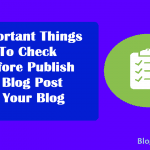Forbes, TechCrunch, The Huffington Post, CIO, The Next Web and other big names in the blogging world post a few thousand blogs monthly. The content is deemed the best, and these sites are regarded as authority sites.
Looking at the huge number of articles published on these sites, you are left wondering: how often (and how many) should you post new content on your blog. Compared to these behemoth sites, your one article a week is an insignificant number, and you might feel like you are not doing enough. But, at your blog’s scale/ level of growth, what should you look at when determining your posting frequency?
As insurmountable as the pressure to publish great content frequently is, how do you balance the scale between the quantity of articles published and the quality of your content?
To answer these questions, first, we take a look at Google’s stance on publishing content frequently.
Google’s special Query Deserves Freshness (QGF) ranking factor gives priority and prominence to the newest stories in the search engine visibility. Which is why you get the most recent results when you ask Google for information.
But, the date and time of posting are not all that the QDF ranking factor looks at. Google notes that this ranking factor returns search results after considering the hottest topics or the most recent event, reoccurring events, as well as frequent updates.
Edits, site updates, and frequency of the updates to your blog also determine how high you rank.
So, how often should you post new content and what should guide your content posting frequency and strategy?
Contents In Page
Content marketing strategy
Even when targeting a hot topic and trying not to miss posting content related to the recent trending news, lack of a strategy and a goal easily means that you will miss your mark.
Part of your marketing strategy is reaching the right audience with the most useful and relevant content out there. For this, you require a lot of time in content creation, content distribution, social media marketing, email marketing, social networking, and list building, among others. Taking all these into consideration and putting them against the size of your blog/ business, then you will arrive at the best frequency for posting content for your blog. One article per week or day rather than 5 articles daily makes more sense for small businesses and new blogs.
Number of blogs already published
The traffic to your blog largely depends on the number of blogs already published on your blog. To attract readers who stick with you from the beginning, you need to start on high ground by publishing high-quality. You don’t expect to be a new kid on the block if you publish terrible content.
It’s important to mention that with a higher number of blogs published, your blog easily ranks high and you get more traffic.
Traffic Sources and Channels
You also need to check your traffic channels. This way, you know who you are writing for and what they need.
It is, therefore, clear that posting new content on the blog regularly will increase your chances of success.
Some of the things that happen when you blog frequently include:
Building a community
Every blogger wishes to be associated with a community. This community will comment on your latest blog, and you will learn from each other. That level of engagement pushes you higher on the map and your content highly regarded, especially by search engines. To get such a high level of engagement, you have to blog consistently. You have to nurture your audience with great content, regularly.
Increase in opportunities to rank higher
When you have a few blog posts published, you are less visible to search engines. This changes when your blog has tens of articles published. Moving from 10 to 100 articles increases your ranking tenfold.
An excited audience
By publishing more high-quality and helpful content, you create a community of excited audience that always looks forward to your next pieces.
Competitive Edge
When your blog has numerous articles published frequently, you compete with the big boys. To get started on this, check what your competitors do, how often they publish, and the average length of their articles.
Lastly, you can define/ manage your resources, and establish credibility with your audience, while boosting your blog’s visibility.
How frequent should your posting be?
If you have been in the business for a while, you probably have heard people say that you should post every day. Though frequent posting increases visibility, daily posting may not work in your favour.
The problem with posting every day is that it can create monotony among your readers. This strategy can destroy social proof and make your readers not find your blog posts interesting anymore.
As you think about the frequency of your posts, you should aim at not killing their interest in your content. You can achieve this by avoiding daily posting strategy.
Another reason why you should avoid daily posting is because it destroys reader bonding. People often have busy schedules, and they may not get the time to read your blog posts if you publish them every day.
They may end skipping some posts and fail to bond with your content.
The strategy can also destroy your subscriber counts. If you keep on sending posts through email every day, some of your subscribers may unsubscribe especially if your blog is still new.
It is advisable that you post frequently but not every day so that you can avoid such challenges. Try to plan the posts wisely as you think about the content you would like to share with your readers.
Before you sit down and start writing, craft your content and think of an idea that many people would resonate with.
The best strategy to use when it comes to the frequency of blog posts is posting a couple of times a week. Though posting every day can help you maintain a routine, it can kill the connection between you and your readers.
Three- four posts every week is a good strategy to use. Readers don’t like a blogger who overdoes the posting.
When you skip a day, your readers become eager and curious about what you are going to give them next, and they long for your next posts.
Avoid posting daily for the sake of it but post regularly for readers to follow each post carefully without skimming.
When you post thrice in one week, you get the chance to give them in-depth posts and have enough time to construct it well.
This way, you raise your chances of getting comments, tweets, and links per every post. You also have sufficient time to engage your readers in the comment section and address each one of them personally.
As you post thrice, you get the liberty to give them long posts of about 1000 words.
Remember to focus on fresh content so that all of your posts remain relevant for a long time.
Though working with other bloggers can help you improve your skills, you should develop a personal routine and only write out of inspiration instead of following another blogger’s routine.
You can plan your blogs posts with the help of a content calendar.
Make sure that you can follow your schedule to the letter and avoid changing important things abruptly. Feel free to survey your followers to establish the frequency they are comfortable with when it comes to how you post your content.
Avoid making blogging feel like a chore that you need to do every day.








